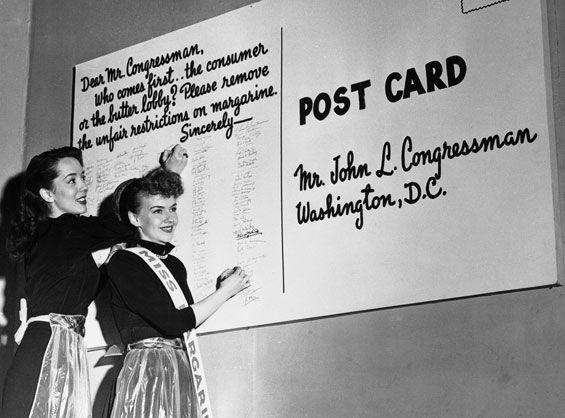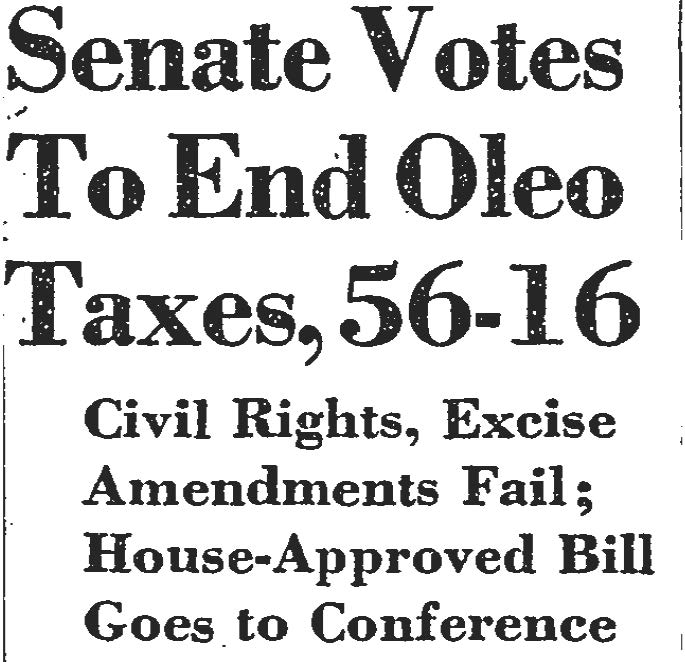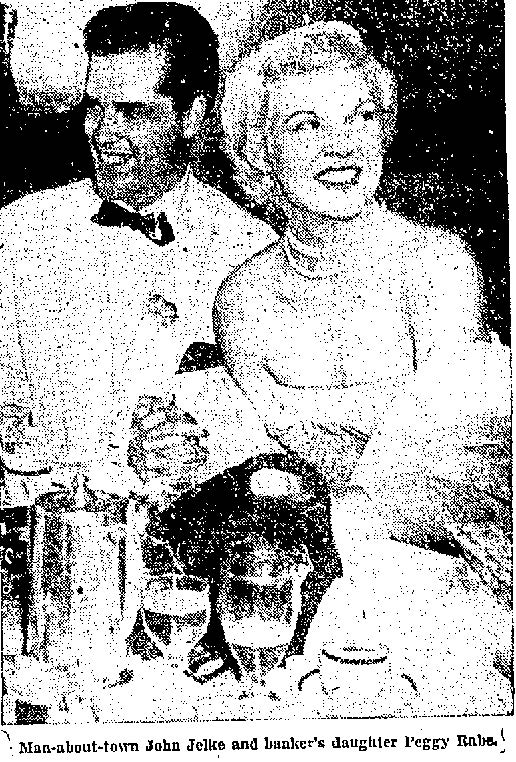•••
The Foster Mother
Oleo reform seemed dead, and Truman appeared to be headed for defeat in the 1948 election, but the polls and at least one newspaper had it all wrong. “DEWEY DEFEATS TRUMAN” was the famous headline in the Jelkes’ hometown paper, the Chicago Tribune, which incorrectly reported victory for the Republican candidate in an early edition. With Truman’s reelection, civil rights were in, but so was oleo reform. Its link to the Dixiecrats could not kill the reform momentum and, before the election, Truman had announced his support for the repeal of the federal tax—perhaps to gain votes in the South, perhaps because he realized that in many of the Democratic states, even dairy states, there was widespread support for yellow oleo. The Democrats had regained control of both chambers, and Truman was determined to carry through with his campaign promises.
 Lever Brothers and the rest of the margarine industry began planning one final direct assault on the anti-margarine laws. Lever Brothers had assembled an army to wage the last battle in the color wars. Extensive lobbying of Congress picked up momentum in 1949 and the spring of 1950. The lobbying (financed and supported by Lever Brothers and other margarine concerns) was led by American housewives,—the same consumers targeted by John F. Jelke a half-century earlier. They had grown tired of white margarine and their wrists ached from trying to color margarine in the kitchen. They readily enlisted in the margarine industry’s effort to defeat the dairy lobby. The housewives held picket marches in front of Congress carrying signs such as “We Want Margarine Tax Free!” They instituted drives for consumers to sign postcards addressed to members of Congress urging the repeal of the federal tax: “Dear Mr. Congressman, Who comes first…the consumer or the butter lobby? Please remove the unfair restrictions on margarine.” They testified before Congress.
Lever Brothers and the rest of the margarine industry began planning one final direct assault on the anti-margarine laws. Lever Brothers had assembled an army to wage the last battle in the color wars. Extensive lobbying of Congress picked up momentum in 1949 and the spring of 1950. The lobbying (financed and supported by Lever Brothers and other margarine concerns) was led by American housewives,—the same consumers targeted by John F. Jelke a half-century earlier. They had grown tired of white margarine and their wrists ached from trying to color margarine in the kitchen. They readily enlisted in the margarine industry’s effort to defeat the dairy lobby. The housewives held picket marches in front of Congress carrying signs such as “We Want Margarine Tax Free!” They instituted drives for consumers to sign postcards addressed to members of Congress urging the repeal of the federal tax: “Dear Mr. Congressman, Who comes first…the consumer or the butter lobby? Please remove the unfair restrictions on margarine.” They testified before Congress.
In January 1950, the oleo bill re-surfaced, pushed by the Dixiecrats and the President. The proposed measure had not lost any of its controversy, and the Senate quickly split, buttermen vs. oleo men, Republicans vs. Democrats. Senator Joseph McCarthy was a tough squat ex-Marine nicknamed “Tail Gunner Joe” who flew a dozen or so missions as a gunner-observer in the Pacific Theater and then in 1946 managed to win one of the Wisconsin Senate seats, beating Robert LaFollette in the primary. Wisconsin was a dairy state, and McCarthy knew that the spread on his political bread was butter. He advocated an amendment to the proposed bill that outlawed unfair and misleading advertising of oleo, including any phrase that suggested that the two products were alike. Phrases like “freshly churned” or “country fresh” would be banned, McCarthy explained, as would photographs or other depictions of dairy scenes on oleo packages. McCarthy was joined by another dairyman, George Aiken, a Republican from Vermont, who charged that the oleo manufacturers had an unlawful monopoly and were misleading the public into believing that the repeal of the tax would lead to lower prices for the weak-sister product. He too wanted to ban any advertisement of oleo that made the spread appear like butter.
Oleo legislation, however, was not at the top of the Truman’s administration agenda. Civil rights were, championed in large part by Hubert Humphrey, a Democrat from Minnesota, a dairy state. Humphrey had decided to split with the Democrats on the issue of oleo tax repeal because, like McCarthy, his constituents were buttermen. He called for an investigation into the monopolistic practices of the oleo industry, where five companies including The John F. Jelke Company produced two-thirds of the vegetable spread. At the same time, Humphrey tried to rally the Democrats to support Truman’s proposed civil rights legislation. The Southern Democrats—including the Dixiecrats who had bolted the party in 1948—were opposed to any federal intrusion into that area. Realizing this, one Republican Senator from North Dakota, another dairy state, tried to derail the oleo bill by attaching three civil rights amendments to it. This was a common tactic used at the time by Senators whenever they wanted to kill a proposed bill. The civil rights amendments, which outlawed poll taxes, established federal punishment for lynching and forbade racially discriminatory employment practices, were considered the automatic death knell for any bill because the Southern Democrats would filibuster any attempt at civil rights reform. The Senators from the dairy states, Republicans and Democrats alike, ferociously argued that the repeal of the oleo tax endangered America’s way of life. Republican Alexander Wiley, from butter-loving Wisconsin, tried to persuade the Dixiecrats that support for oleo reform was un-American: with a wink and a nod toward White Supremacy, he asserted that “the dairy cow is the foster mother of the race.” But the Senate stopped the proposed civil rights amendments, voting to table each rider. Finally the oleo bill, without any amendments, was brought to the Senate floor for a vote. The measure passed easily and Harry S. Truman signed the bill into law.
 The Act of March 16, 1950, better known as the Margarine Act of 1950, finally allowed yellow margarine to be manufactured and sold without burdensome federal taxes or license fees. The federal act still required that colored margarine be appropriately labeled and packaged when sold. In a nod to the dairy states, it required that margarine served in a public eating place be labeled as such or served in a triangular pat. It also allowed states to continue to regulate margarine, and some did, but the color wars were effectively over. The margarine industry had prevailed. Free of the oppressive federal taxes, oleo could finally compete with butter.
The Act of March 16, 1950, better known as the Margarine Act of 1950, finally allowed yellow margarine to be manufactured and sold without burdensome federal taxes or license fees. The federal act still required that colored margarine be appropriately labeled and packaged when sold. In a nod to the dairy states, it required that margarine served in a public eating place be labeled as such or served in a triangular pat. It also allowed states to continue to regulate margarine, and some did, but the color wars were effectively over. The margarine industry had prevailed. Free of the oppressive federal taxes, oleo could finally compete with butter.
With the new leglislation, Congress opened the doors to the sale of yellow margarine, and one after another, states repealed their laws that restricted the sale of the butter substitute. By August 1952, there were only seven states that still had anti-margarine laws, and several of those appeared ready to legalize the sale of yellow oleo. The market had opened up, and Americans responded by eating more-and-more oleo. In an August 4, 1952, front-page article, the Wall Street Journal noted the trend and boldly predicted that within a few years, Americans would consume more margarine annually than butter.
The end of the color wars signaled the start of another struggle—the “battle of the brands.” Television was also emerging as the new medium for advertisement, and soon the airways were full of commercials about oleo. One margarine was pretty much like the next, except in the advertising world, which touted the characteristics of one indistinguishable butter substitute over another: the smoothness, the ingredients, the packaging. Jack Jelke would have liked to be in that battle—at the forefront, hawking Good Luck Margarine, and he thought that his father would have relished such an opportunity. But Jack Jelke was on the sidelines, suffering through an uneasy retirement and worrying about his children.
Jack Jelke had hoped to spend the years after his retirement in bliss, but he found that life in his empty Lake Forest, Illinois, mansion was lonely. He was sad that the family business had not continued, and he was not happy with his sons, particularly Johnny, who had become a regular in the York City nightclubs frequented by the Café Society and was often in the gossip columns as dating one young debutante or another. But Johnny also seemed to be a bad influence on his younger brother, Mickey, who had graduated from the Taft School in Connecticut and, after a one-year stint in the Army, had been spending more and more time in the City. Mickey’s name was gradually making its way into the gossip columns, linked with models and other young lovelies. Jack Jelke had seen the publicity that surrounded his father’s trial and conviction. He had experienced the media frenzy surrounding Frazier’s two divorces. Jack Jelke was a private man. He shunned the limelight and hoped that his children would lead quiet and happy lives. His hopes did not come true.
 Johnny and Mickey first made headlines in late 1949 when they became involved in a brawl at the El Morocco, a New York City club made famous as one of Ed Sullivan’s haunts. The Jelkes and their dates were sipping champagne in the club, famously decorated in a blue tiger-stripe motif, when Humphrey Bogart and a friend, Bill Seeman, arrived carrying two large stuffed pandas, each about four feet in height and weighing about 20 pounds. Bogart and Seeman sat the pandas on a table and started drinking. At the urging of the El Morocco’s press agent, Mickey’s date, a model named Robin Roberts, tried to pick up one of the pandas. Bogart took offense and grabbed her wrist. According to Roberts, Bogart pushed her over a chair to the ground. Johnny’s date, a shapely blonde named Peggy Rabe, described later by the press as the daughter of a banker, intervened and pushed Bogart, who pushed back. Mickey barged in. Somebody, perhaps Johnny or his date, started throwing plates, and Johnny had a dinner plate smashed over his shoulders. Waiters and bouncers jumped in to put down the fracas. Bogart was thrown out of the club. Johnny became a celebrity for standing up to the Hollywood actor: the next day, Johnny would be quoted by the newspapers as saying that Bogart was “beginning to believe his own scripts.” The El Morocco banned Bogart, and Roberts brought criminal assault charges against him.
Johnny and Mickey first made headlines in late 1949 when they became involved in a brawl at the El Morocco, a New York City club made famous as one of Ed Sullivan’s haunts. The Jelkes and their dates were sipping champagne in the club, famously decorated in a blue tiger-stripe motif, when Humphrey Bogart and a friend, Bill Seeman, arrived carrying two large stuffed pandas, each about four feet in height and weighing about 20 pounds. Bogart and Seeman sat the pandas on a table and started drinking. At the urging of the El Morocco’s press agent, Mickey’s date, a model named Robin Roberts, tried to pick up one of the pandas. Bogart took offense and grabbed her wrist. According to Roberts, Bogart pushed her over a chair to the ground. Johnny’s date, a shapely blonde named Peggy Rabe, described later by the press as the daughter of a banker, intervened and pushed Bogart, who pushed back. Mickey barged in. Somebody, perhaps Johnny or his date, started throwing plates, and Johnny had a dinner plate smashed over his shoulders. Waiters and bouncers jumped in to put down the fracas. Bogart was thrown out of the club. Johnny became a celebrity for standing up to the Hollywood actor: the next day, Johnny would be quoted by the newspapers as saying that Bogart was “beginning to believe his own scripts.” The El Morocco banned Bogart, and Roberts brought criminal assault charges against him.
The criminal case was well publicized, with throngs waiting for Bogart as he entered the courtroom. The Jelke boys would be witnesses. In a pre-trial statement to the press, Bogart said that he was a “loveable character, about as vicious as Margaret O’Brien,” referring to the MGM child star, then age twelve. After a court hearing the charges against Bogart were dismissed for lack of evidence. The New York magistrate presiding over the case thought the entire affair a publicity stunt by El Morocco. Afterwards, when asked if he had struck Roberts, Bogart added, with a smile, “Me hit a lady? Never.”
Johnny Jelke’s standing up to Bogart made him a minor celebrity among the nightclub set. He was a man’s man, a war hero and heir to a large fortune. And Mickey wanted to be like Johnny. Their father disapproved of course, as did Lever Brothers. It did not like having the name Jelke in the news and so decided to re-tool its prized brand. Lever Brothers had been marketing “Jelke’s Good Luck Margarine” under that name for a little over a year after it purchased the Jelke company, but it soon dropped “Jelke’s” and started selling it as simply “Good Luck Margarine.” In a further effort to distance the brand from the Jelkes, Lever Brothers dropped the Dutch Girl as a symbol and instead adopted a green four-leaf clover as the brand’s mark. The Jelke name and symbol had been erased from the grocery store shelves, and Jack Jelke was not happy that his family's efforts over the last seventy years had vanished within a few months. He blamed his spoiled sons and their lifestyle for the disappearance of the Jelke name.
Jack Jelke began to think about what to do with the oleo fortune. Little did he know that the Good Luck Margarine fortune would prove to be unlucky for the next generation of Jelkes. Only two of Jack Jelke’s children would live long enough to receive any of the oleo dough. Another would end up in prison.